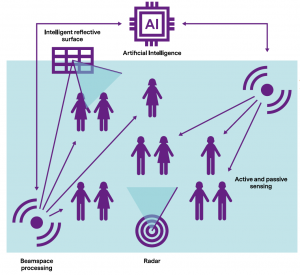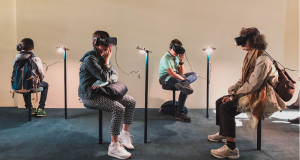Published on: April 19, 2021
Welcome to our latest blog. In this blog, we will discuss one of the most promising applications that 5G and other mmWave technologies can offer: user device positioning and localization. Localization is the process of determining the location (position coordinates) of a user device in a given area. In general, localization with radio is done by computing the distance (range) and direction of the received/transmitted radio signal between the user device and some reference transmitters (anchors). These measurements are then merged to estimate the position of the user device. This is the working principle used in common positioning devices such as the global positioning system (GPS) and cellular positioning.
Localization with mmWaves
To explain this application, we need to understand two important properties of mmWave signals for communication: the quasi-optical nature of mmWave radio frequency signals and the large bandwidth at high frequencies. The quasi-optical nature results in sharp, narrow beamwidth signals with low scattering upon reflections. These narrow beams, enabled by the use of a large number of antenna arrays, help in gathering accurate angle information such as angle of arrival (AoA), angle of departure (AoD), and the received signal strength information (RSSI) [1]. The large bandwidth available at high frequencies enables high-resolution time measurements such as time of arrival (ToA) or time difference of arrival (TDoA) at the transmitter/receiver device. Once these parameters are available at our disposal, the localization shrinks down to a simple geometric problem that can be solved either by triangulation or trilateration. Depending upon the mmWave technology in use, the methodology used for localizing a node changes. For example, 5G and 5G New Radio (NR) waveforms have specific orthogonal frequency division multiplexing (OFDM) based modulation frames which help in easy extraction of time-based information, either at the Base Station or the user device. In indoor scenarios, where 60 GHz Wireless LAN systems (based on IEEE 802.11ad standard) are deployed, the sharp and narrow beamwidths help with precise angle information extraction from the acquired channel state information (CSI). Fig. 1 shows an illustration of the AoA and ToA information. ToA and TDoA help in the estimation of the range (distance) d by using the simple formula: d = c . t, where c is the speed of light and t is the ToA at the user. Fig. 1(a) shows how the range information d1, d2, d3 is used for trilateration, to estimate the user position. Figure 1(b) shows how the angles of arrival 𝛼i at different base stations are used to triangulate the user position.

Fig. 1: Illustration of Trilateration and Triangulation using ToA and AoA information [1].
There are other classical ways of localizing a device: Fingerprinting based methods, which use algorithms to best match the signal parameters to a known database of the signal characteristics in a given environment, and Hybrid techniques that employ algorithms using a combination of the above signal parameters for localization [1]. A wide variety of different techniques employing machine learning algorithms, deep learning models, and other signal processing techniques are also being used for localization, under the Fingerprinting and hybrid techniques umbrella [2].
How can location information be used?
Location information can be used to optimize the network performance, for both indoor and outdoor environments. In indoor environments, device location can help reconfigure the wireless links between client devices and base stations (to avoid obstacles (like walls or other non-reflective surfaces), movement, and mutual blockage among users) [3]. Once we have the user position, we can intelligently direct the mmWave beams to provide a reliable link for high data-rate communication. In the outdoor context, these are popularly referred to as location-aided or location-aware communications. These can help provide location-based services to the users. The base station can use the user location information to effectively steer the transmission beams, thus improving the system capability, providing high throughputs, and seamlessly increasing the coverage [4].
Use-cases of position information in mmWave network deployments
Indoor mmWave deployments are currently restricted to technologies of 60 GHz WLAN networks that are based on IEEE 802.11ad standard. Knowledge of position information is very important for many of the applications. For example, augmented reality (AR) and virtual reality (VR) applications require low latency communication and high data rates [5]. Positioning is necessary for ultra-reliable low latency communication (URLLC) for Industry 4.0 applications such as AR-supported assembly lines, Industrial IoT, smart manufacturing, robot localization for tools tracking, and warehouse management.
In 5G cellular deployments, location information is crucial for smart city applications such as intelligent traffic monitoring, unmanned aerial vehicle (UAV) communication for parcel logistics, emergency rescue services, vehicular communication for autonomous driving, etc. [6].
Future of positioning in Beyond 5G Era
With 5G NR almost ready to be rolled out worldwide, the investigation towards the key enabling technologies for the 6G wireless standards has already begun. Researchers envision that the next generation of mobile communication will provide intelligent, seamless, and ubiquitous wireless connectivity with data rates of Terabits per second (Tbps) and extremely low latency [4]. This can only be possible with highly accurate positioning. Some of the promising technologies that offer a solution to this problem are reflective intelligent surfaces (as explained in our previous blog [7]), meta-material-based surfaces, and imaging using mmWave Radars, which are emerging prominent areas of research. Machine Learning and AI algorithms will also play a key role in enhancing communication systems to provide accurate positioning information [8]. Fig. 2 is an illustration of promising technologies that can yield high accuracy positioning in the future generation of wireless communications. With the fast-paced development of new technologies and techniques in this field, there is great optimism that the problem of accurate positioning can be solved before the proposal for the 6G standard.

Fig 2: Illustration of the promising technologies and opportunities for accurate localization [8].
Some of our ESRs in the MINTS project are working on devising accurate device localization and environment mapping algorithms to improve the network performance using various mmWave technologies. We are also working in close collaboration with other researchers in the project for various positioning-based application use-cases. So keep tuned for exciting insights that may come from one of our members in the future!
If you were able to stick until the end and can’t wait for more content and you also want to know about us and our projects, you can always follow our social media channels.
References:
[1] J. A. del Peral-Rosado, R. Raulefs, J. A. López-Salcedo, and G. Seco-Granados, “Survey of Cellular Mobile Radio Localization Methods: From 1G to 5G,” in IEEE Communications Surveys & Tutorials, vol. 20, no. 2, pp. 1124-1148, Second quarter 2018, doi: 10.1109/COMST.2017.2785181.
[2] O. Kanhere and T. S. Rappaport, “Position Location for Futuristic Cellular Communications: 5G and Beyond,” in IEEE Communications Magazine, vol. 59, no. 1, pp. 70-75, January 2021, doi: 10.1109/MCOM.001.2000150.
[3] Palacios, P. Casari, H. Assasa and J. Widmer, “LEAP: Location Estimation and Predictive Handover with Consumer-Grade mmWave Devices,” IEEE INFOCOM 2019 – IEEE Conference on Computer Communications, Paris, France, 2019, pp. 2377-2385, doi: 10.1109/INFOCOM.2019.8737434.
[4] Xiao, Zhiqiang & Zeng, Yong. (2020). An Overview on Integrated Localization and Communication Towards 6G.
[5] https://www.ericsson.com/en/blog/2020/12/5g-positioning–what-you-need-to-know
[6] https://www.iis.fraunhofer.de/en/ff/lv/lok/5g.html
[7] https://b5g-mints.eu/ris-blog6/
[8] A. Bourdoux, “6G White Paper on Localization and Sensing.” ArXiv abs/2006.01779 (2020)





